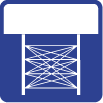Seismic methods
Geotomographie provides complete solutions for borehole and near-surface seismic surveys.

Tomography
Description: Seismic tomography provides high-resolution 2D or 3D images of seismic velocities between boreholes. The method is used to delineate geological structures, to map cavities and weak zones and to specify mechanical soil and rock properties. Geophysicists and engineers apply this method to investigate the foundation and underlying rock of buildings and bridges in order to characterize the subsurface before infrastructure is built and to image time-dependent processes.
Applications: Dissaggregation zones, sinkholes, karst structures, settlements, deep tomography

Crosshole
Description: The crosshole test provides a depth profile of shear wave velocities (VS) and compressional wave velocities (VP) between boreholes at a high vertical resolution. The method is used to determine soil dynamic parameters, such as shear modulus, Poisson ratio and Young’s modulus. Engineers use these key parameters to predict the response of soils to dynamic loading.
Applications: Determination of elastic soil parameters

Downhole
Description: The downhole test provides shear wave velocities (VS) and compressional wave velocities (VP) for geological layers along a single borehole. Soil dynamic parameters, such as shear modulus, Poisson ratio and Young’s modulus can be determined to evaluate the soil’s response to dynamic loading. The downhole test has a lower vertical resolution than the crosshole test.
Applications: Determination of elastic soil parameters

Refraction
Description: Refraction seismic utilizes seismic waves being refracted on geological layers. The method is used to image velocity contrasts of the subsurface. Changes in lithology and the degree of fracturing can be mapped and geological structures, such as faults and cavities can be identified. The method is used for a detailed subsurface characterization in a variety of engineering site investigations.
Applications: Fault zones, depth to bedrock, weak zones

MASW
Description: The MASW (Multichannel analysis of surface waves) utilizes the dispersion of seismic surface waves. The method provides 1D or 2D depth profiles of shear wave velocities. As the S-wave velocity is closely related to soil stiffness the method is commonly used for various types of geotechnical engineering purposes related to foundation design.
Applications: Site classification according to EC8 and DIN4149, strength characterization of dykes and dams

Reflection
Description: The main purpose of reflection seismics is to acquire a 2D or 3D image of S-wave reflections as a function of depth. The acquired data can be used for the evaluation of the lateral continuity of geological layers, which will be associated with reflectors. Reflections and diffractions usually occur at other geological structures as well, such as volcanic craters and fault or marine controlled depocentres.
Applications: Layer boundaries
Other geophysical methods
Additionally other near-surface geophysical methods are offered by Geotomographie.

Geomagentic
Description: The method of geomagnetic based on the highly accurate measurement of the earth magnetic field. Archaeological objects in the ground like masonry fundaments or former, now-filled trenches and pits or burns usually have a slightly different magnetization compared to the surrounding soil. This creates a local anomaly in the Earth's magnetic field at the surface above the object. Depending on the magnetization of the object and its location and orientation this leads to an increase or decrease of the local magnetic field which can be mapped.
Applications: Archaeological objects and structures

Geoelectric
Description: For the investigation of shallow sediments geoelectrical resistivity methods are most common as they provide a fast mapping and reliable results. Modern geoelectrical equipment is light-weight and can be operated by one or two persons in the field. The principle of the geoelectric method is to measure the apparent electric resistivity of the subsurface using a four-electrode array. In this case the current is injected between two steel electrodes and depending on earth resistance an electrical potential is measured between the two other steel electrodes. If the distance between the electrodes is increased a deeper penetration can be achieved. Thus, the subsurface can be mapped at different depth levels.
Applications: Clay exploration, gravel exploration, homogeneous areas of dykes and dams, archaeological foundations and walls

Gravimetry
Description: Earth gravitational field is subject to spatial and temporal variations. It is measured in units of acceleration. The value of acceleration is affected by different geological units. Rocks with a high density lead to a higher acceleration value than rocks with lower density. In the extreme case of a "zero density" there is a cavity which leads to a significant reduction in the force of gravity. Variations of the Earth's gravitational field can be measured using a gravimeter. To detect cavities gravimeters must have a high resolution.
Applications: Cavities

Electromagnetic
Description: Electromagnetic surveys provide measurements of variability in subsurface conductivity and are widely used for environmental studies. In these methods an electromagnetic field generated by a transmitter coil induces a secondary field or response in the mediums being investigated. The secondary field is distinguished from the primary field by a phase lag acquired by a receiver coil. By operating at different frequencies and coil separations depth penetration and resolution can be varied for different applications.

Georadar
Description: Georadar explores the subsurface using electromagnetic radar waves which are being reflected at target objects and layer boundaries. Radar impulses are sent out by a transmitter antenna. These pulses propagate downwards and getting reflected on buried objects and structures. Reflected or back scattered waves are recorded at a receiver antenna. Frequencies used ranging between 10 MHz und 1000 MHz, depending on target depth and requested resolution. The recorded data are presented in radargrams which display the reflection structures in terms of amplitude variations versus travel time.
Applications: Subsidence, depth of archaeological objects

